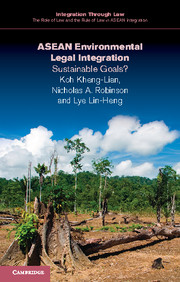Book contents
- Frontmatter
- Contents
- List of tables
- General editors’ preface
- Foreword – Professor Tommy
- Acknowledgments
- Introduction: exploring environmental law in Southeast Asia
- 1 ASEAN and environmental sustainability
- 2 Integrating sustainability into ASEAN state practice
- 3 The environment in the ASEAN region
- 4 Environmental sustainability laws in the ASEAN member states
- 5 ASEAN collaboration towards environmental sustainability
- 6 ASEAN and climate disruption
- 7 Conclusions: ASEAN's challenging way forward
- Executive summary
- Appendix A ASEAN organizational structure relevant to the environment – the ASEAN Charter
- Appendix B Founding of ASEAN – a short history
- Index
Introduction: exploring environmental law in Southeast Asia
Published online by Cambridge University Press: 05 April 2016
- Frontmatter
- Contents
- List of tables
- General editors’ preface
- Foreword – Professor Tommy
- Acknowledgments
- Introduction: exploring environmental law in Southeast Asia
- 1 ASEAN and environmental sustainability
- 2 Integrating sustainability into ASEAN state practice
- 3 The environment in the ASEAN region
- 4 Environmental sustainability laws in the ASEAN member states
- 5 ASEAN collaboration towards environmental sustainability
- 6 ASEAN and climate disruption
- 7 Conclusions: ASEAN's challenging way forward
- Executive summary
- Appendix A ASEAN organizational structure relevant to the environment – the ASEAN Charter
- Appendix B Founding of ASEAN – a short history
- Index
Summary
The environmental performance of most ASEAN Member States, as assessed by reputable studies, is above the world average, and the ecological footprint is much lower than that of many nations. However, ASEAN will continue to face growing environmental challenges given the need to lift a third of its population earning less than $2 a day out of poverty, and the many other pressures exerted on the environment such as population growth, urbanization and industrialization.
Dr. Surin Pitsuwan, ASEAN Secretary-GeneralEnvironment is sans frontières. Many of the current or emerging environmental problems are transnational and transboundary, necessitating legal integration, whether in the form of hard or soft laws, programs, policies or governance innnovations, such as ASEAN Dialogue Partners, or the United Nations Environment Programme consultations. All these are crucial to ASEAN.
ASEAN is part of the global order for environmental sustainability. It is a partner of the United Nations in the field of development. As the 1971 Stockholm Conference on the Human Environment and the 1992 “Earth Summit” at Rio De Janiero have made clear, we the peoples of the United Nations and of ASEAN alike, share one world, one atmosphere, one stratosphere. ASEAN's economic pillar requires integration to move Southeast Asia forward, and environment must move in tandem to prevent degradation of ecosystems for development to be sustainable regionally and globally.
This monograph examines the phenomenon of “integration through law” (ITL), or more particularly how the member states of ASEAN employ law as a means of regional integration, focusing in particular on how this process functions in the context of environmental conservation and sustainable development. The several chapters trace ASEAN's struggles to integrate environment within its own community and also with the global community. There are many concerns, not only in terms of the lack of institutional capacity and funding, but in the very nature of environmental problems. The environmental sciences have taught nations how complicated and interrelated human impacts are on the climate or ecosystems. States are left grappling with solutions. The search for environmentally sustainable progress is an ongoing, adaptive process, often without clear, immediate answers. This complexity is compounded by too many inputs that national sectors receive from diverse interdisciplinary studies, without any governance system to connect them.
- Type
- Chapter
- Information
- ASEAN Environmental Legal IntegrationSustainable Goals?, pp. 1 - 12Publisher: Cambridge University PressPrint publication year: 2016



